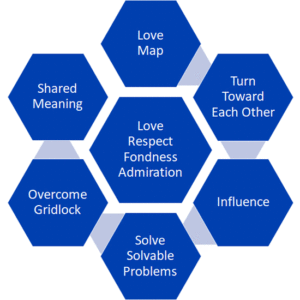“People with the greatest expectations for their marriages usually wind up with the highest quality marriages.” – Dr. John Gottman
A couple of months ago, I wrote about Dr. John Gottman and his “Love Lab” at the University of Washington. This lab is an apartment that hosts couples for short stays while monitoring their behavior and select biometrics (with all due respect for privacy). Through observational analysis, scientists predict with 91% accuracy which couples will endure. The last post covered healthy and unhealthy ways to navigate conflict. This one summarizes findings from Gottman’s book, The Seven Principles of Making Marriage Work.
 Not surprisingly, happy marriages are based on deep friendship in which the partners share mutual respect and genuine enjoyment of each other’s company. Trust and commitment are “weight-bearing walls.” The partners have faith in one another and let positive sentiments about the relationship override negativity as it arises. Each person’s happiness is contingent in part of the other’s feelings. They support one another’s hopes and aspirations.
Not surprisingly, happy marriages are based on deep friendship in which the partners share mutual respect and genuine enjoyment of each other’s company. Trust and commitment are “weight-bearing walls.” The partners have faith in one another and let positive sentiments about the relationship override negativity as it arises. Each person’s happiness is contingent in part of the other’s feelings. They support one another’s hopes and aspirations.
With that backdrop, Dr. Gottman and his colleagues unearthed the following seven strategies for cultivating an emotionally intelligent marriage.
Principle #1: Enhance Your Love Maps. A love map characterizes a partner’s joys, likes, dislikes, fears, stresses, hobbies, interests, etc. When we enhance our love maps, we are making cognitive space for deep knowledge of our partners. We stay attuned to changes in their lives. We can more ably predict what they are thinking and feeling. These sensibilities help us provide effective support and enable us to navigate conflict successfully.
Principle #2: Nurture Your Fondness and Admiration. Focus on your partner’s positive qualities and express appreciation for them. Take pride in the other and your history together. These habits of mind cultivate the sense that one’s partner is worthy of love and respect. We find it easier to like as well as love them.
Principle #3: Turn Toward Each Other Instead of Away. We each make “bids” for attention, affection, and support throughout the day. Successful couples turn toward their partners and respond 86% of the time; those who eventually divorce turn toward only 33% of the time. Such interactions can be as simple as looking out of the window and saying, “Wow. What a beautiful day,” and the other responding by looking up and saying, “I know!” Turning toward also means that when our partners need us, our worlds stop, and we are 100% present for them.
Principle #4: Let Your Partner Influence You. Share power. Consult one another in important decisions and take the input seriously. Be a team player.
Principle #5: Solve Your Solvable Problems. As they arise, get in touch with your own feelings and sensibilities while cultivating empathy for your partner. Recognize that there are two valid sides to the story and take responsibility for your part in engendering conflict. Then communicate effectively by: (i) Establishing a safe space to enter into discussion; (ii) Make and receive “repair attempts” to de-escalate tension; (iii) Soothe yourself and each other by taking “time outs,” listening to music, going for walks, etc.; (iv) Finding common ground and compromise; and, (v) Processing any residual grievances so that they don’t fester.
Principle #6: Overcome Gridlock. Even with the best of intentions and stellar communication skills, we may stumble upon irreconcilable differences. Dr. Gottman finds that these matters tend to be signs of hopes, aspirations, and wishes that are a part of one’s identity and confer meaning and purpose. They are frequently rooted in childhood. So, the task at hand involves getting behind the surface level tension and figuring out why a position carries such weight. That understanding may open up avenues of flexibility, illumine pathways for support, and establish ground rules for compromise, even if temporary. Again, the core of the discussion centers on mutual respect and high regard.
Principle #7: Create Shared Meaning. This practice has to do with what it means to be a family member and how we build a life together. Its four pillars are: (i) Rituals of connection – i.e., structures or routines that are enjoyable and reinforce intimacy; (ii) Support for each other’s roles as spouses, parents, sons/daughters, friends, employees, hobbyists, etc.; (iii) Shared goals; and, (iv) Shared values and symbols.
Dr. Gottman’s book provides gaggle of exercises through which couples can explore these principles in depth. It’s well worth a careful read.